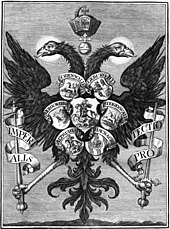Knight's canton of Steigerwald

A community of knightly noble families in the Steigerwald is referred to as the knightly canton of Steigerwald , who had risen to ministeriality as servants of various imperial princes since the high Middle Ages and until the mediatization of the knighthood or the regional principalities at the beginning of the 19th century, the feudal lordship over numerous villages and estates in the Steigerwald and in adjacent areas. The imperial knighthood principalities and thus also the knightly canton of Steigerwald were dissolved in 1806.
Structure of the knight circles
The free imperial knighthood in Germany has been divided into a Rhenish , a Franconian and a Swabian knight circle, which in turn consisted of different cantons. The knightly canton Steigerwald belonged to the Franconian knight circle and had its office in Erlangen .
Noble families in the canton of Steigerwald
The following noble families belonged to the knightly canton of Steigerwald until 1806:
- Mountain 1529
- Bernheim 1529
- Barons of Bibra on Schwebheim and Obereurheim
- Crailsheim 1529
- Dettelbach 1529
- Dobeneck 1529
- Egloffstein 1529
- Ehenheim 1529
- Frankenstein 1529
- Fox 1529
- Giech 1529
- Gnottstadt 1529
- Haller von Hallerstein
- Heinach 1529
- Heßberg (Barons) 1529
- Hutten 1529
- Barons von Künsperg zu Nagel on Schernau
- Lamprecht 1529
- Laufenholz 1529
- Lochinger 1529
- Lochner
- Spoon wood from Kolberg
- Barons of Mauchenheim called Bechtolsheim on Mainsondheim
- Spleen 1529
- Neustetter 1529
- Barons of Pölnitz on Aschbach
- Randersacker
- Roesch 1529
- Rusenbach 1529
- Schaumberg 1529
- Barons von Seckendorff in Sugenheim and Mühlhausen (also 1529)
- Salsa 1529
- Stiebar 1529
- Theler 1529
- Thungfeld 1529
- 1529
- Vestenberg 1529
- Waldenfels 1529
- Wenckheim 1529
- London 1529
- Winkler von Mohrenfels
- Wolf of Wolfsthal
- Zindt 1529
- Zollner von Halberg 1529
Organization and administration
In the case of Steigerwald, too, the canton formed the "basic association" of the imperial knights organized in it. He performed all those tasks for which the political influence and, above all, the economic potential of the individual knight comrade was insufficient. Therefore, the cooperative life took place primarily at the level of the canton, which also acted as the direct representation of the interests of its members. For this purpose, the canton or local directorate stood at the head of the knightly place. This committee, also known as the local or quarter board, comprised a knight captain who, as "Primus inter Pares" (Mauchenheim, Volume 1, 154), headed several councils of chivalry or knight directors. Like the former, these were ordered for life.
Knight captains
As knight captains have been handed down:
- 1496 Hans Fuchs von Bimbach
- 1562 Velte Fuchs von Wiesentheid
- 1575 Georg Ludwig von Seinsheim
- Hans Sigmund of Crailsheim
- 1587 Theobald Julius von Thüngen
- 1602 Hans Friedrich von Crailsheim
- 1606 Hans Joachim von Stiebar († 1616)
- (1610) 1617 Joachim Christoph von Seckendorff
- 1627 Hans Christoph Stiebar von Buttenheim († 1635)
- (1629?) 1641 Joachim Christoph von Seckendorff († 1650)
- 1651 Hans Wolf von Wolfsthal
- 1652 Johann Philipp von Seckendorf
- 1671 Johann Friedrich von Lendersheim († 1678)
- 1677 Philipp Gaston Wolf von Wolfsthal
- 1717 Johann Philipp von Seckendorff
- 1723 Philipp Dietrich von Schrottenberg († 1725)
- 1727 Marquard Karl Christoph Anton von Pönitz
- 1743 Johann Wilhelm Friedrich von Seckendorff († 1770)
- 1770 Constantin von Mauchenheim gt. Bechtolsheim
- 1781 Friedrich Carl von Seckendorff († 1796)
- 1796 Leopold von Egloffstein
literature
- Johann Gottfried Biedermann : Gender register of the Reichs-Frey-immediate knights of the country to Francken laudable place Steigerwald . Nuremberg 1748.
- Johann Kaspar Bundschuh Attempt of a historical-topographical-statistical description of the immediate Freyen imperial knighthood in Franconia according to its six locations , Ulm 1801, digitized at: Bayerische Staatsbibliothek
- List of the canton Rhön / Werra from 1529, StAM GHA II. No. 211 aE printed in:
Cord Ulrichs: Vom Lehnshof zur Reichsritterschaft - Structures of the Franconian lower nobility at the transition from the late Middle Ages to the early modern period . Franz Steiner Publishing House. Stuttgart 1997. ISBN 3-515-07109-1 . Google Book pp. 211-212. - Michael Puchta: Imperial Knighthood, Canton Steigerwald in: Historisches Lexikon Bayerns
Individual evidence
- ^ Karl Siegfried Bader : The German Southwest in its territorial state development , Koehler, Stuttgart 1950
- ↑ Michael Puchta
- ^ Gerhard Pfeiffer: Studies on the history of the Frankish imperial knighthood; Special print from: Yearbook for Franconian State Research, Volume 22, 1962, pp. 198–197.

